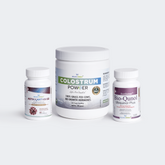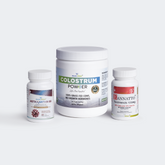Estimated Reading Time: 7 minutes
|Female sex hormones have a significant impact on general health, affecting mood, metabolism, the reproductive system, and bone density, among other things. Being educated about these hormones makes it easier for women to adapt during various life stages, from adulthood to menopause, and make appropriate choices for their well-being. This guide will detail the essential female sex hormones, their role, and how their imbalance can affect your health.
What Are Female Sex Hormones?
Hormones are chemical messengers that help control many aspects of the body's function. The ovaries and adrenal glands produce the female sex hormones, mainly estrogen, progesterone, and testosterone. These hormones work in tandem to regulate the menstrual cycle, support pregnancy, and even influence general health beyond reproduction itself.
3 Main Female Sex Hormones
-
Estrogen
Estrogen is responsible for developing secondary sexual characteristics in females, such as breast development and preparation of the uterus for menstruation. Estrogen also regulates the menstrual cycle, supports bone health, and affects skin, brain function, and cardiovascular health.
-
Progesterone
Progesterone, often referred to as the “pregnancy hormone,” plays a key role in getting the uterus ready for pregnancy and keeping it that way. It regulates the menstrual cycle, balances estrogen levels, and helps maintain mood stability.
-
Testosterone
While often thought of as the male hormone, testosterone is also crucial for women. It is associated with muscle size, sex drive, mood regulation, and energy levels.
Role of Hormones Throughout a Woman’s Life
1. Puberty: Changes and Effects
Puberty is the stage of life at which a girl’s body starts to develop into a mature sexual form. The hypothalamus, a region of the brain, initiates puberty by signaling the pituitary gland to stimulate hormone production in the ovaries.
Every month, estrogen levels surge to develop the female anatomy, including breasts and pubic hair, and also trigger the onset of menstruation (menarche). Emotional ups and downs, mood swings, and greater sensitivity due to surging hormone levels can also be part of this stage.
2. Hormone Fluctuations Through Different Phases of the Menstrual Cycle
The menstrual cycle consists of four distinct phases, and hormonal changes control each of them:
-
Menstrual Phase (Days 1-5): As estrogen and progesterone are low, the uterine lining sheds, leading to menstruation.
-
Follicular Phase (Days 1-13): The pituitary releases follicle-stimulating hormone (FSH), causing the ovaries to mature follicles. As estrogen levels spike, the uterine lining thickens in anticipation of pregnancy.
-
Ovulation Phase (Day 14): A surge in luteinizing hormone (LH) triggers the release of a mature egg from the ovary, accompanied by a spike in estrogen, a brief rise in testosterone, and an increase in libido.
-
Luteal Phase (Days 15-28): Progesterone increases to help maintain a potential pregnancy. If fertilization does not happen, levels of progesterone and estrogen fall, causing menstruation.
3. Hormones and Sexual Desire
Sexual desire, or libido, is significantly influenced by hormones. Estrogen and testosterone are especially powerful. Testosterone is a major driver of sexual desire, arousal, and energy levels, though in women, it exists in smaller amounts than in men.
Estrogen maintains vaginal health, blood flow, and natural lubrication — all of which contribute to sexual pleasure. Like testosterone, progesterone can sometimes suppress sexual desire, especially during the second half of the menstrual cycle.
During pregnancy, post-partum, menopause, and even during stress, there can be hormone fluctuations that can affect the sexual drive of women, and they must understand where and when things start to change and what strategies to fix it.
Hormones shape a woman’s life from puberty to old age, influencing her physical, emotional, and reproductive health at every stage.
Also Read: Breaking barriers: The Impact of Geranylgeraniol on Testosterone Levels
4. Pregnancy and Postpartum: Supporting Pregnancy, Shifting After Childbirth
In pregnancy, estrogen and progesterone skyrocket, aiding in fetal development and keeping the uterine lining intact. Human chorionic gonadotropin (hCG) maintains early pregnancy, and relaxin softens ligaments in readiness for delivery.
After giving birth, hormone levels drop sharply, which can lead to postpartum depression and mood swings, as well as changes in metabolism.
Then there’s prolactin, which is released in elevated amounts to help clear the way for milk production, and oxytocin, which helps promote bonding with the baby and helps the uterus return to its pre-pregnancy size.
As a result of these hormonal changes, new moms may experience physical and emotional challenges.
Also Read: Understanding Bovine Colostrum for Babies: Nutritional Insights for Parents.
5. Perimenopause and Menopause
Perimenopause refers to the transition stage leading up to menopause, and it usually starts in a woman’s 40s.
Estrogen and progesterone levels change, leading to symptoms like:
-
Erratic cycles
-
Hot flashes
-
Night sweats
-
Mood swings
-
Sleep disturbances
Menopause is when a woman has had 12 consecutive months without a menstrual period, typically between the ages of 45 and 55.
The estrogen levels decrease drastically, resulting in symptoms like:
-
Vaginal dryness
-
Bone density loss (which raises the risk of osteoporosis)
-
Weight gain
-
Increased risk of heart disease
Hormone replacement therapy (HRT) and lifestyle changes can help manage symptoms and support long-term health.
6. Postmenopause and Aging
After menopause comes a period of hormone stability at a lower level, during which time women may experience the long-term effects of reduced estrogen, an increased risk of osteoporosis, heart disease, and cognitive decline.
Staying healthy through an appropriate diet and exercise, and going for regular medical check-ups, can help reduce these risks.
Knowing about hormones' role isn't enough; one should also know about common hormonal imbalances and their symptoms to understand what's wrong with the body.
Also Read: Heart Health for Women Over 45: Can Tocotrienols be the Rescuer?
Common Hormonal Imbalances & Symptoms
Hormonal imbalances can precipitate many health problems, such as:
-
Mood Disorders: Symptoms include mood changes, anxiety, depression, and mood swings.
-
Polycystic Ovary Syndrome (PCOS): Symptoms include increased androgen levels, erratic periods, and insulin insensitivity.
-
Thyroid Disorders: Symptoms include weight changes, sensitivity to cold or heat, fatigue, and hair loss.
How to Maintain Hormonal Balance Through Lifestyle
Lifestyle is essential for overall health, particularly for women, as hormones impact various life stages. Understanding lifestyle changes can help maintain hormonal balance for a healthier life. Here are the top 3 changes to consider:
-
Nutrition and Diet
Eating a well-balanced diet full of healthy fats, fiber, and protein helps hormones stay balanced. Flaxseeds and leafy greens, as well as omega-3 fatty acids, are foods that are good for hormonal balance.
Pro-tip: If a busy lifestyle leads to an insufficient diet, hormone-supporting supplements can be a wise option when taken under professional guidance.
-
Regular Exercise
Regular exercise helps to balance estrogen and insulin levels, lowering the risk of hormonal imbalances. A balanced routine of exercise is very important to keep hormones in balance and to feel energetic.
-
Sleep and Stress Management
High cortisol levels due to chronic stress and lack of sleep can alter hormonal levels. Practicing relaxation techniques such as meditation and adhering to a routine sleep schedule can be beneficial.
When to See a Doctor
Women with symptoms such as irregular periods, severe fatigue, unexplained weight fluctuations, and persistent mood changes should see a healthcare provider. You can restore balance using hormonal testing and treatment options, including lifestyle changes and medication. Hormonal contraceptives may regulate or suppress the menstrual cycle, and hormone replacement therapy (HRT) is frequently used during menopause.
Conclusion
Female sex hormones are important for overall health, not just reproduction. These hormones control the menstrual cycle, affect mood, metabolism and energy levels, and are critical for bone and cardiovascular health. Knowing how estrogen, progesterone, and testosterone flow during the different life stages—puberty, pregnancy, menopause, and aging—can empower women to take steps to rebalance hormones proactively.
With education and proactive measures, women can empower themselves to take charge of their hormonal well-being, paving the way for a quality lifestyle and longevity. Whether you are going through adolescence, pregnancy, menopause, or beyond, knowledge of female sex hormones helps women make decisions that support their physical and emotional well-being throughout life.
FAQs
Q1. What is the normal estrogen level for a female?
Estrogen levels are age-dependent and vary with the menstrual cycle phase. Normal estradiol (a type of estrogen) ranges are:
-
Follicular phase: 30-100 pg/mL
-
Ovulatory phase: 100–400 pg/mL
-
Luteal phase: 60-200 pg/mL
-
Postmenopause: Below 30 pg/mL
Q2. What happens when women have low testosterone?
Low testosterone in women can cause fatigue, low libido, decreased muscle mass, weight gain, mood swings, and trouble concentrating.
Q3. What are the effects of high levels of estrogen in a woman?
If your estrogen levels are too high, you can experience weight gain, irregular periods, mood swings, bloating, headaches, and a greater risk of conditions like estrogen dominance, fibroids, or endometriosis.
Q4. What does testosterone do for women?
Testosterone is important in maintaining muscle mass, bone density, libido, mood, and overall energy. It also plays a role in cognitive function and mental well-being.
Q5. What role do hormones play in mood swings?
Estrogen and progesterone, Emory University neuroscientist numbers, are hormones that impact neurotransmitters in the brain that facilitate mood stabilization. Premenstrual syndrome (PMS), pregnancy, and menopause imbalances can lead to anxiety, depression, or irritability.
Q6. What are the symptoms of hormonal imbalance in women?
Symptoms can include irregular periods, fatigue, changes in weight, acne, hair thinning, mood swings, and sleep disturbances.
Q7. Can Diet and Lifestyle balance Female Hormones?
Yes! A balanced diet, stress management, regular exercise, and sleep can all help support hormonal balance.
Disclaimer: The material provided in this article is for purely educational and informational purposes and should not be used as a substitute for professional medical advice, diagnosis, or treatment. Always consult with your physician or other qualified healthcare provider with any questions regarding a medical condition.
References
-
Brazier, Y. (2023) What to know about puberty. https://www.medicalnewstoday.com/articles/156451#what-happens:~:text=What%20happens%20during%20puberty%3F.
-
Cappelletti, M. and Wallen, K. (2015) 'Increasing women’s sexual desire: The comparative effectiveness of estrogens and androgens,' Hormones and Behavior, 78, pp. 178–193. https://doi.org/10.1016/j.yhbeh.2015.11.003.
-
Estrogen’s effects on the female body (2022). https://www.hopkinsmedicine.org/health/conditions-and-diseases/estrogens-effects-on-the-female-body#:~:text=Estrogen%27s%20Effects%20on%20the%20Female%20Body.
-
Unlocking Vital insights: The Comprehensive Guide to Female Hormones | RF Hospital blog (no date). https://www.rfhospital.org/blog/well-women-centre/everything-you-need-to-know-about-female-hormones#:~:text=Everything%20you%20need%20to%20know%20about%20female%20hormones.






































